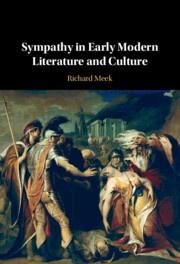Book contents
- Sympathy in Early Modern Literature and Culture
- Sympathy in Early Modern Literature and Culture
- Copyright page
- Contents
- Figures
- Acknowledgements
- Note on Texts
- Introduction
- Chapter 1 ‘A sympathy of affections’
- Chapter 2 ‘Compassion and mercie draw teares from the godlyfull often’
- Chapter 3 ‘Grief best is pleased with grief’s society’
- Chapter 4 ‘O, what a sympathy of woe is this’
- Chapter 5 ‘Soveraignes have a sympathie with subjects’
- Chapter 6 ‘As God loves Sympathy, God loves Symphony’
- Coda
- Bibliography
- Index
- Sympathy in Early Modern Literature and Culture
- Sympathy in Early Modern Literature and Culture
- Copyright page
- Contents
- Figures
- Acknowledgements
- Note on Texts
- Introduction
- Chapter 1 ‘A sympathy of affections’
- Chapter 2 ‘Compassion and mercie draw teares from the godlyfull often’
- Chapter 3 ‘Grief best is pleased with grief’s society’
- Chapter 4 ‘O, what a sympathy of woe is this’
- Chapter 5 ‘Soveraignes have a sympathie with subjects’
- Chapter 6 ‘As God loves Sympathy, God loves Symphony’
- Coda
- Bibliography
- Index
Summary
The Coda reflects upon the central arguments of the book as a whole, via an exploration of Edward Reynolds’s A treatise of the passions and faculties of the soule of man (1640). The elaborate metaphors used in Reynolds’s treatise have been used by some critics to suggest that, as Gail Kern Paster puts it, the passions ‘act within the body just as the forces of wind and waves act in the natural world’. By contrast, I consider Reynolds’s treatise in relation to his printed sermons, and argue that his conception of sympathy and the passions was spiritual, intellectual, and rhetorical. The fact that Reynolds draws upon variety of classical texts – including works by Homer, Virgil, Horace, and Seneca – as well as scientific and religious concepts, reminds us of the plurality and complexity of early modern emotional experience. This final case study thus demonstrates how my revised history of sympathy speaks to wider critical and methodological debates about early modern passions – and the history of emotions more generally.
- Type
- Chapter
- Information
- Sympathy in Early Modern Literature and Culture , pp. 253 - 266Publisher: Cambridge University PressPrint publication year: 2023

